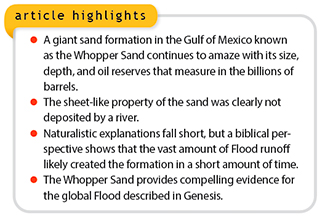 In the last three years, Shell Oil Company has made three significant discoveries in the Whopper Sand, a massive offshore Cenozoic sedimentary deposit in the Gulf of Mexico.1-3 These new finds further extend the oil production in the Whopper Sand. Last year, a well by the oil company Equinor stretched the Whopper Sand southeast.4 The three Shell discoveries are about 200 miles east of Brownsville, Texas, in an area known as the Perdido Fold Belt. All three new discoveries were likely made in the Lower Cenozoic (Paleogene) unit known as the Whopper Sand.
In the last three years, Shell Oil Company has made three significant discoveries in the Whopper Sand, a massive offshore Cenozoic sedimentary deposit in the Gulf of Mexico.1-3 These new finds further extend the oil production in the Whopper Sand. Last year, a well by the oil company Equinor stretched the Whopper Sand southeast.4 The three Shell discoveries are about 200 miles east of Brownsville, Texas, in an area known as the Perdido Fold Belt. All three new discoveries were likely made in the Lower Cenozoic (Paleogene) unit known as the Whopper Sand.
Shell’s latest prospect, known as Leopard, found over 600 feet of net pay (the oil-producing part of a sand unit).1 Twenty miles to the west, Shell had found more than 1,400 feet of net pay in their “Whale” discovery in 2018.2 And in 2019, they reported a total of 400 feet of net pay in their Blacktip well, about 20 miles north of Leopard.3 These new discoveries add significantly to the 15 billion barrels of oil already discovered in the Whopper Sand.5
The Whopper Sand was first discovered about 200 miles off the coast in the deep Gulf of Mexico in 2001.5 The first well penetrated an unexpected 1,300 feet of nearly pure sand near the bottom of the Paleogene interval, coincident with the base of the Tejas Megasequence.5
Surprisingly, the newly discovered sand had sharp boundaries on the top and bottom.6
“This was also puzzling, since we were trained to expect gradational coarsening-upward bedding during regression [sea level drop] and fining-upward during transgression [sea level rise], rather than the sharp contacts we were seeing,” wrote Joshua Rosenfeld, a retired oil geologist.6
Furthermore, Rosenfeld described the sand layer “as being sheet-like rather than channelized.” Apparently, no river systems, such as the Mississippi River, could have formed the Whopper Sand.6
Uniformitarian scientists remain puzzled. How could a massively thick and clearly defined sand layer reach these depths and distances offshore? Drilling proves that these sands are thicker and more extensive than initially imagined. Although geologists have found some channelized (river-like) sands and pancake-like thin sands in deeper parts of the Mississippi Delta, it was thought that thick pure sands could not be transported great distances out to sea (200-plus miles).
The recent discoveries by Shell confirm that the Whopper Sand extends beyond 40,000 square miles across the deep Gulf of Mexico in water depths approaching 10,000 feet.7 It is commonly over 1,000 feet thick and can be up to 1,900 feet thick.7
A naturalist worldview proves insufficient to explain how the Whopper Sand formed, but biblical history provides a reasonable answer. The Whopper Sand was likely deposited as floodwaters shifted direction and began to drain off the North American continent after Day 150 of the Genesis Flood. The resulting high-energy sheet flow was able to transport a massive volume of sand a great distance into the deep water of the Gulf. As the water eventually slowed, more clay and less sand were deposited. Today, we find the Gulf dominated by clay deposition.
These discoveries confirm that the receding phase of the Flood in the Gulf of Mexico began with the deposition of the Whopper Sand (onset of the Tejas Megasequence) and that the entire Tejas represents deposition during the receding phase of the Flood.7 The Whopper Sand is a testament to the awesome power of the global Flood.
References
- Shell finds oil at Leopard in deepwater Gulf of Mexico. Offshore. Posted on off-shore mag.com May 11, 2021.
- Shell announces large deep-water discovery in Gulf of Mexico: Whale. Green Car Congress. Posted on greencarcongress.com February 1, 2018.
- Addison, V. Shell makes deepwater discovery in Gulf of Mexico. Hart Energy. Posted on hartenergy.com April 24, 2019.
- Clarey, T. Another New ‘Whopper Sand’ discovery. Creation Science Update. Posted on ICR.org April 11, 2020.
- Clarey, T. 2015. The Whopper Sand. Acts & Facts. 44 (3): 14.
- Rosenfeld, J. H. 2020. Paleogene drawdown of the Gulf of Mexico: An ongoing controversy. The AAPG Explorer. 41 (4): 14-19.
- Clarey, T. 2020. Carved in Stone: Geological Evidence of the Worldwide Flood. Dallas, TX: Institute for Creation Research, 334-335.
* Dr. Clarey is Research Associate at the Institute for Creation Research and earned his Ph.D. in geology from Western Michigan University.





